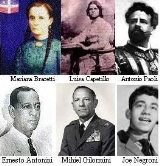
Corsican immigration to Puerto Rico
Encyclopedia
Corsican immigration to Puerto Rico |
|||||||
|---|---|---|---|---|---|---|---|
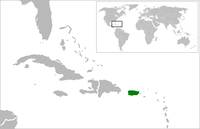 Location of the island of Puerto Rico (green) |
|||||||
| Geographical similarities between both islands | |||||||
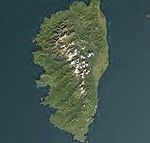 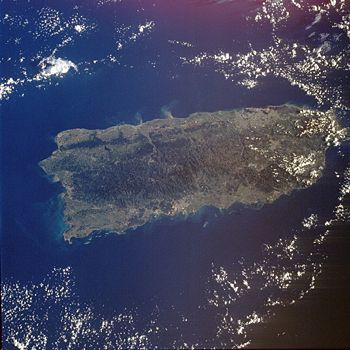 |
|||||||
Corsican immigration to Puerto Rico
Puerto Rico
Puerto Rico , officially the Commonwealth of Puerto Rico , is an unincorporated territory of the United States, located in the northeastern Caribbean, east of the Dominican Republic and west of both the United States Virgin Islands and the British Virgin Islands.Puerto Rico comprises an...
came about as a result of various economic and political changes in the mid-19th century Europe; among those factors were the social-economic changes which came about in Europe
Europe
Europe is, by convention, one of the world's seven continents. Comprising the westernmost peninsula of Eurasia, Europe is generally 'divided' from Asia to its east by the watershed divides of the Ural and Caucasus Mountains, the Ural River, the Caspian and Black Seas, and the waterways connecting...
as a result of the Second Industrial Revolution, political discontent and widespread crop failure due to long periods of drought, and crop diseases. Another influential factor was that Spain
Spain
Spain , officially the Kingdom of Spain languages]] under the European Charter for Regional or Minority Languages. In each of these, Spain's official name is as follows:;;;;;;), is a country and member state of the European Union located in southwestern Europe on the Iberian Peninsula...
had lost most of its possessions in the so-called "New World
New World
The New World is one of the names used for the Western Hemisphere, specifically America and sometimes Oceania . The term originated in the late 15th century, when America had been recently discovered by European explorers, expanding the geographical horizon of the people of the European middle...
" and feared the possibility of a rebellion in its last two Caribbean possessions—Puerto Rico and Cuba. As a consequence the Spanish Crown had issued the Royal Decree of Graces (Real Cedula de Gracias) which fostered and encouraged the immigration of Catholics of non-Hispanic origin to its Caribbean Colonies.
The situation and opportunities offered, plus the fact that the geographies of the islands are similar, were ideal for the immigration of hundreds of families from Corsica
Corsica
Corsica is an island in the Mediterranean Sea. It is located west of Italy, southeast of the French mainland, and north of the island of Sardinia....
to Puerto Rico. Corsicans and those of Corsican descent have played an instrumental role in the development of the economy of the island, especially in the coffee industry.
19th century Corsica

Italy
Italy , officially the Italian Republic languages]] under the European Charter for Regional or Minority Languages. In each of these, Italy's official name is as follows:;;;;;;;;), is a unitary parliamentary republic in South-Central Europe. To the north it borders France, Switzerland, Austria and...
and southeast of France
France
The French Republic , The French Republic , The French Republic , (commonly known as France , is a unitary semi-presidential republic in Western Europe with several overseas territories and islands located on other continents and in the Indian, Pacific, and Atlantic oceans. Metropolitan France...
. Corsica belonged to the Republic of Genoa
Genoa
Genoa |Ligurian]] Zena ; Latin and, archaically, English Genua) is a city and an important seaport in northern Italy, the capital of the Province of Genoa and of the region of Liguria....
(before Genoa became part of Italy) and in 1768 was ceded to France to pay off debt. The island relied largely on its agricultural economy for survival.
Certain changes occurred in Europe
Europe
Europe is, by convention, one of the world's seven continents. Comprising the westernmost peninsula of Eurasia, Europe is generally 'divided' from Asia to its east by the watershed divides of the Ural and Caucasus Mountains, the Ural River, the Caspian and Black Seas, and the waterways connecting...
during the end of the 18th century and beginning of the 19th century that would greatly affect the lives of the French and the people of Corsica. One of those changes came about with the advent of the Second Industrial Revolution
Second Industrial Revolution
The Second Industrial Revolution, also known as the Technological Revolution, was a phase of the larger Industrial Revolution corresponding to the latter half of the 19th century until World War I...
. With the Second Industrial Revolution, many of the people who worked in agriculture began to move to the larger cities with hopes of finding better jobs and better lives. Also, there was a widespread crop failure due to long periods of drought and crop diseases (e.g., the phylloxera
Phylloxera
Grape phylloxera ; originally described in France as Phylloxera vastatrix; equated to the previously described Daktulosphaira vitifoliae, Phylloxera vitifoliae; commonly just called phylloxera is a pest of commercial grapevines worldwide, originally native to eastern North America...
epidemic destroyed the Corsican wine industry), cholera
Cholera
Cholera is an infection of the small intestine that is caused by the bacterium Vibrio cholerae. The main symptoms are profuse watery diarrhea and vomiting. Transmission occurs primarily by drinking or eating water or food that has been contaminated by the diarrhea of an infected person or the feces...
epidemic and a general deterioration of economic conditions. Thus, many of the farms in Corsica began to fail.
There was also widespread political discontent characterized by bitter armed conflict. King Louis-Philippe of France was overthrown in the Revolution of 1848 and a republic
Republic
A republic is a form of government in which the people, or some significant portion of them, have supreme control over the government and where offices of state are elected or chosen by elected people. In modern times, a common simplified definition of a republic is a government where the head of...
was declared with a Provisional Government. Three new political groups emerged during that era: they were the liberals
Liberalism
Liberalism is the belief in the importance of liberty and equal rights. Liberals espouse a wide array of views depending on their understanding of these principles, but generally, liberals support ideas such as constitutionalism, liberal democracy, free and fair elections, human rights,...
, radical
Radicalism (historical)
The term Radical was used during the late 18th century for proponents of the Radical Movement. It later became a general pejorative term for those favoring or seeking political reforms which include dramatic changes to the social order...
s and the socialists. The combination of man-made and natural disasters in Corsica created an acute feeling of hopelessness. All this came about at a time when Spain
Spain
Spain , officially the Kingdom of Spain languages]] under the European Charter for Regional or Minority Languages. In each of these, Spain's official name is as follows:;;;;;;), is a country and member state of the European Union located in southwestern Europe on the Iberian Peninsula...
was growing fearful of the possibility of a rebellion in her Caribbean possessions, which consisted of Puerto Rico
Puerto Rico
Puerto Rico , officially the Commonwealth of Puerto Rico , is an unincorporated territory of the United States, located in the northeastern Caribbean, east of the Dominican Republic and west of both the United States Virgin Islands and the British Virgin Islands.Puerto Rico comprises an...
and Cuba
Cuba
The Republic of Cuba is an island nation in the Caribbean. The nation of Cuba consists of the main island of Cuba, the Isla de la Juventud, and several archipelagos. Havana is the largest city in Cuba and the country's capital. Santiago de Cuba is the second largest city...
.
Spanish Royal Decree of Graces
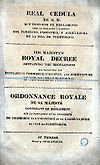
South America
South America is a continent situated in the Western Hemisphere, mostly in the Southern Hemisphere, with a relatively small portion in the Northern Hemisphere. The continent is also considered a subcontinent of the Americas. It is bordered on the west by the Pacific Ocean and on the north and east...
and Central America
Central America
Central America is the central geographic region of the Americas. It is the southernmost, isthmian portion of the North American continent, which connects with South America on the southeast. When considered part of the unified continental model, it is considered a subcontinent...
and sought measures of preventing a repeat of this in the Caribbean. It was decided that an influx of Catholic
Catholic
The word catholic comes from the Greek phrase , meaning "on the whole," "according to the whole" or "in general", and is a combination of the Greek words meaning "about" and meaning "whole"...
immigrants from Ireland
Ireland
Ireland is an island to the northwest of continental Europe. It is the third-largest island in Europe and the twentieth-largest island on Earth...
, Corsica and Italy would provide a loyal base for the Crown and appeals were made to encourage immigration. In 1815, the Spanish Crown had issued the Royal Decree of Graces
Royal Decree of Graces of 1815
The Royal Decree of Graces of 1815 is a legal order approved by the Spanish Crown in the early half of the 19th century to encourage Spaniards and later Europeans of non-Spanish origin to settle and populate the colonies of Cuba and Puerto Rico....
(Real Cedula de Gracias) which fostered the immigration of Catholics of non-Hispanic
Hispanic
Hispanic is a term that originally denoted a relationship to Hispania, which is to say the Iberian Peninsula: Andorra, Gibraltar, Portugal and Spain. During the Modern Era, Hispanic sometimes takes on a more limited meaning, particularly in the United States, where the term means a person of ...
origin to its Caribbean colonies, Puerto Rico and Cuba.
The island of Puerto Rico is very similar in geography to the island of Corsica and therefore appealed to the many Corsicans who wanted to start a "new" life. Under the Spanish Royal Decree of Graces, the Corsicans and other immigrants were granted land and initially given a "Letter of Domicile" after swearing loyalty to the Spanish Crown and allegiance to the Catholic Church. After five years they could request a "Letter of Naturalization" that would make them Spanish subjects.
Influence in coffee industry
Hundreds of Corsicans and their families immigrated to Puerto Rico from as early as 1830, and their numbers peaked in the early 1900s. The first Spanish settlers settled and owned the land in the coastal areas, the Corsicans tended to settle the mountainMountain
Image:Himalaya_annotated.jpg|thumb|right|The Himalayan mountain range with Mount Everestrect 58 14 160 49 Chomo Lonzorect 200 28 335 52 Makalurect 378 24 566 45 Mount Everestrect 188 581 920 656 Tibetan Plateaurect 250 406 340 427 Rong River...
ous southwestern region of the island, primary in the towns of Adjuntas, Lares
Lares, Puerto Rico
Lares is a small mountain municipality of Puerto Rico's central-western area located north of Maricao and Yauco; south of Camuy, east of San Sebastián and Las Marias; and west of Hatillo, Utuado and Adjuntas. Lares is spread over 10 wards and Lares Pueblo...
, Utuado
Utuado, Puerto Rico
Utuado is a municipality of Puerto Rico located in the central-western mountainous region of the island known as La Cordillera Central. It is located north of Adjuntas and Ponce; south of Hatillo and Arecibo; east of Lares; and west of Ciales and Jayuya. In land area it is the third-largest...
, Ponce, Coamo
Coamo, Puerto Rico
Coamo is a municipality in Puerto Rico located in the southern region, north of Santa Isabel; south of Orocovis and Barranquitas; east of Villalba and Juana Díaz; and west of Aibonito and Salinas. Coamo is spread over 10 wards and Coamo Pueblo...
, Yauco
Yauco, Puerto Rico
Yauco is a city and municipality in southwestern Puerto Rico located in the southern coast of the island by the Caribbean, south of Maricao, Lares and Adjuntas; east of Sabana Grande and Guánica; and west of Guayanilla. Yauco is spread over 20 wards and Yauco Pueblo...
, Guayanilla
Guayanilla, Puerto Rico
Guayanilla is a municipality of Puerto Rico located in southern coast of the island, bordering the Caribbean Sea, south of Adjuntas, east of Yauco; and west of Peñuelas and about 12 miles west of Ponce. Guayanilla is spread over 16 wards and Guayanilla Pueblo...
and Guánica
Guánica, Puerto Rico
Guánica is a municipality in southwestern Puerto Rico located on southern coast, bordering the Caribbean Sea, south of Sabana Grande, east of Lajas, and west of Yauco. It is part of the Yauco Metropolitan Statistical Area....
. However, it was Yauco
Yauco, Puerto Rico
Yauco is a city and municipality in southwestern Puerto Rico located in the southern coast of the island by the Caribbean, south of Maricao, Lares and Adjuntas; east of Sabana Grande and Guánica; and west of Guayanilla. Yauco is spread over 20 wards and Yauco Pueblo...
whose rich agricultural area attracted the majority of the Corsican settlers. The three main crops in Yauco were coffee
Coffee
Coffee is a brewed beverage with a dark,init brooo acidic flavor prepared from the roasted seeds of the coffee plant, colloquially called coffee beans. The beans are found in coffee cherries, which grow on trees cultivated in over 70 countries, primarily in equatorial Latin America, Southeast Asia,...
, sugar cane and tobacco
Tobacco
Tobacco is an agricultural product processed from the leaves of plants in the genus Nicotiana. It can be consumed, used as a pesticide and, in the form of nicotine tartrate, used in some medicines...
. The new settlers dedicated themselves to the cultivation of these crops and within a short period of time some were even able to own and operate their own grocery stores. However, it was with the cultivation of the coffee bean that they would make their fortunes. Cultivation of coffee in Yauco originally began in the Rancheras and Diego Hernández sectors and later extended to the Aguas Blancas, Frailes and Rubias sectors. By the 1860s the Corsican settlers were the leaders of the coffee industry in Puerto Rico and seven out of ten coffee plantations were owned by Corsicans.
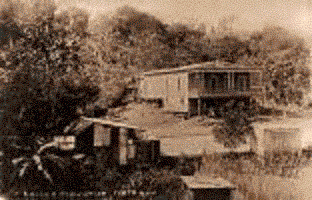
Cotton gin
A cotton gin is a machine that quickly and easily separates cotton fibers from their seeds, a job formerly performed painstakingly by hand...
was converted into a machine which was used in dehusking coffee cherries. Second, they sent two of their own as representatives to visit the important European coffee buying centers. The visit to Europe was a success and thus, Puerto Rico became an important member of the worldwide coffee industry.
The descendants of the Corsican settlers were also to become influential in the fields of education, literature, journalism and politics. Historian, Colonel Hector A. Negroni, (USAF-Retired), researched the Corsican-Puerto Rican connection and has provided with his work a wealth of information about Puerto Rico's ties with Corsica. Today the town of Yauco is known as both the "Corsican Town" and "The Coffee Town". There's a memorial in Yauco with the inscription, "To the memory of our citizens of Corsican origin, France, who in the C19 became rooted in our village, who have enriched our culture with their traditions and helped our progress with their dedicated work - the municipality of Yauco pays them homage." The Corsican element of Puerto Rico is very much in evidence, Corsican surnames such as Paoli, Negroni and Fraticelli are common.
Landmarks in Yauco

National Register of Historic Places
The National Register of Historic Places is the United States government's official list of districts, sites, buildings, structures, and objects deemed worthy of preservation...
.
Casa Franceschi Antongiorgi
The Casa Franceschi Antongiorgi (Franceschi Antongiorgi House) was built in 1907, by the French architect André Troublard, for Alejandro . Franceschi Antongiorgi was a rich landowner and lover of the arts who frequently held banquets, concerts and meetings with visiting artists in his house.Casa Antonio Mattei Lluberas
The Casa Antonio Mattei Lluberas, also called La Casona Césari (Césari House) was built in 1893 by Antonio Mattei Lluberas. This house is also known as "The House with Twelve Doors." Later, it was acquired by Angel Césari Poggi, husband of Angela Antongiorgi Rodríguez. The Césari–Antongiorgi family was instrumental in the development of the sugar industry in the southern region of the island.Chalet Amill
The Chalet Amill was built in 1914 by Architect Tomás Olivari Santoni for Ángel Antongiorgi Paoli. Paoli gave the chalet to his daughter Ana Lucía as a wedding gift when she married Juan Amill Rodríguez. The couple soon divorced and by the mid-1920s the chalet was converted into a hotel. First as the Auristela Hotel and then as the Paris Hotel.Mansion Negroni
The Mansion Negroni (Negroni Mansion), also known as Casa Agostini (Agostini House), was built around 1850 by Antonio Francisco Negroni Mattei. Later it passed to the Agostini Family through the marriage of Maria Victoria Negroni, daughter of Antonio Francisco, and Ignacio Agostini Felipi. . The Agostini family made their fortune in the exportation of coffee. They were the owners of "Sobrinos de Agostini y Compañía" (Nephews of Agostini & Co.). Ángel Pedro Agostini Natali, a member of the family, is credited with inventing the coffee grinder. This machine revolutionized the coffee industry. As a consequence, the island was able to meet the huge demand for Puerto Rican coffee which resulted in the "Golden Age" of Yauco's economy. This house was acquired by the Holy Rosary School in Yauco and a bronze plaque describes its history.Residencia Lluberas-Negroni
The Residencia Lluberas-Negroni, erroneously called The Residencia González Vivaldi (González Vivaldi Residence) was built in 1880 by Arturo Lluberas for his wife Asuncion Negroni. Most recently, it was acquired by the Gonzalez-Vivaldi Family.Surnames
The following is an official list of the surnames of the first 403 Corsican families who immigrated to the Adjuntas, Yauco, Guayanilla, and Guanica areas of Puerto Rico in the 19th Century. This list was compiled by genealogist and historianHistorian
A historian is a person who studies and writes about the past and is regarded as an authority on it. Historians are concerned with the continuous, methodical narrative and research of past events as relating to the human race; as well as the study of all history in time. If the individual is...
Colonel (USAF Ret. ) Hector A. Negroni
Hector Andres Negroni
Colonel Héctor Andrés Negroni is a historian, senior aerospace defense executive, author and the first Puerto Rican graduate of the United States Air Force Academy...
who has done exhaustive research on the Corsican migration and origins of his Negroni family name.
Distinguished "Yaucano(a)s" of Corsican descent
The following is a list of some of the distinguished natives of Yauco of Corsican descent.- Agostini, Amelia (1896–1996) – anthologist, poet, educator, professor in Columbia University
- Franquiz, Jose A. (1906–1967) – poet
- Gilormini, Mihiel "Mike"Mihiel GilorminiBrigadier General Mihiel "Mike" Gilormini , was a United States Air Force officer who served in the Royal Air Force and in the United States Army Air Force during World War II. He was the recipient of the Silver Star, the Air Medal with four clusters and the Distinguished Flying Cross 5 times...
(1918–1988) – World War II hero and Founder of the Puerto Rico Air National Guard. Retired as Brigadier General in the Air National Guard. - Giovannetti, Jose Antonio – educator, poet
- Mariani, Pedro Domingo (1880–1925) – poet, journalist
- Mariani-Ortiz, Lydia – educator, PR rights activist
- Masini-Molini, Jose Antonio "El Corso" (1913–1987) – Agronomist. Director, Land Authority of P.R. (1969–1972) – Director, Sugar Corporation of P.R. (1977–1984)
- Mattei, Andres (1863–1925) – poet, journalist
- Mattei Lluberas, AntonioAntonio Mattei LluberasAntonio Mattei Lluberas , was a businessman and politician who in 1897 planned and led the second and last major uprising against Spanish colonial rule in Puerto Rico, known as the Intentona de Yauco.-Early years:...
(1857–1908) - Leader of the Intentona de YaucoIntentona de YaucoThe Intentona de Yauco a.k.a. the "Attempted Coup of Yauco" of 1897, was the second and last major revolt against Spanish colonial rule in Puerto Rico, staged by Puerto Rico's pro-independence movement....
revolt of 1897 and Mayor of Yauco from 1904 to 1906 - Mignucci Calder, Carlos Armando (1889–1954) – politician, Mayor of Yauco (1944–52), Member of Puerto Rico's Constitutional Assembly (1952)
- Negroni, Hector Andres – First Puerto Rican graduate of the US Air Force Academy, US Air Force Colonel, Fighter Pilot, Senior Aerospace Executive and Historian
- Negroni, Julio Alberto – Electrical Engineer who served as the First President for the Water Works Authority in Puerto Rico.
- Negroni, Santiago – journalist, educator and poet
- Negroni Lucca, Santos (1851–1920) – Puerto Rican patriot and one of the 16 prisoners in El Morro Castle in 1887.
- Negroni Mattei, Francisco (1897–1939) – poet, journalist
- Olivari Santoni, Tomás (1902–1904) – Architect and Mayor of Yauco
- Olivieri Rodriguez, Ulises – poet, journalist
- Pietrantoni Blasini, Julio (1935-2006) - lawyer, banker, head of Puerto Rico Government Development Bank from 1978-1985, president of Banco Roig until acquisition by Banco Popular in 1997
- Rojas Tollinchi, FranciscoFrancisco Rojas TollinchiFrancisco Rojas Tollinchi , was a Puerto Rican poet, civic leader and journalist.-Early years:Rojas Tollinchi was one of five siblings born to Pedro Rojas Perez and Flora Maria Tollinchi Battistini in the barrio Algarrobos in Yauco, Puerto Rico...
, poet, civic leader and journalist. - Semidei Rodríguez, JoséJosé Semidei RodríguezBrigadier General José Semidei Rodríguez . Before becoming a Brigadier General in the Cuban National Army,...
- Brigadier General in the Cuban Liberation Army.
Semidei Rodríguez fought in Cuba's War of IndependenceCuban War of IndependenceCuban War of Independence was the last of three liberation wars that Cuba fought against Spain, the other two being the Ten Years' War and the Little War...
(1895–1898) and after Cuba gained its independence he continued to serve in that country as diplomat.
See also
- Corsican people
- List of notable Puerto Ricans
- Royal Decree of Graces of 1815Royal Decree of Graces of 1815The Royal Decree of Graces of 1815 is a legal order approved by the Spanish Crown in the early half of the 19th century to encourage Spaniards and later Europeans of non-Spanish origin to settle and populate the colonies of Cuba and Puerto Rico....
- Corsican immigration to VenezuelaCorsican immigration to VenezuelaCorsicans coming from the regions of Cap Corse and La Castagniccia started arriving in the first third of 19th Century and settled mainly in the coastal towns of Carúpano and Rio Caribe. Known locally as Los Corsos, Corsicans played a central role in the development of the cocoa industry in Venezuela...

